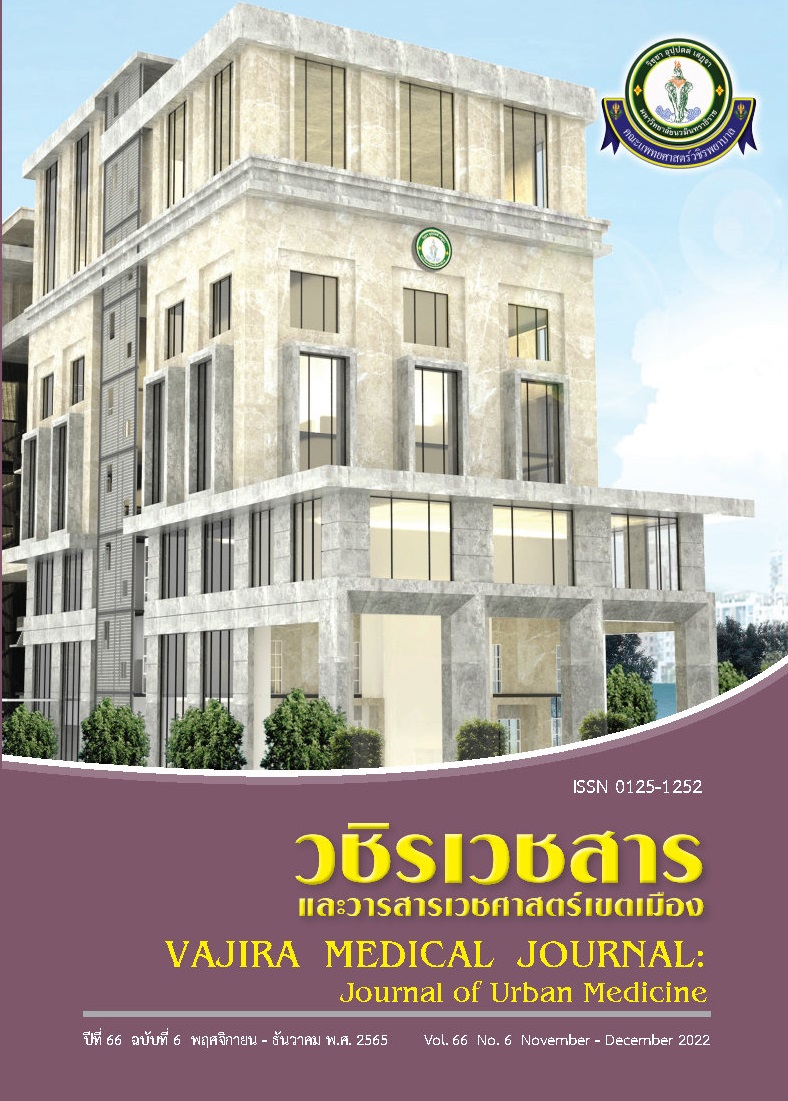Clinical Methicillin-Resistant Staphylococcus aureus May Transfer from Hospital to the Community Through Foods
Main Article Content
Abstract
Objective: To investigate the capability of methicillin-resistant Staphylococcus aureus (MRSA) and mecA-carrying Staphylococcus aureus (MCSA) transfer from hospital to community through foods due to the mecA gene is responsible for various antimicrobials resistance.
Methods: We investigated four MRSA from patients and healthy carriers and one mecA-carrying S. aureus (MCSA) from food, whether they were capable of surviving through acidic condition and simulated gastrointestinal system. All bacterial strains were examined in green papaya salad’s liquid portion (GPL), pH 2.0 and pH 3.0 to test their toleration ability in acidic food. Bacterial toleration to gastrointestinal system was investigated using 0.3% (w/v) pepsin-supplemented phosphate buffer saline (PBS) (pH 2.0 and pH 3.0), and different concentrations bile salt-supplemented tryptic soy broth (TSB). T-test was used to compare the bacterial survival rates at room temperature and 4ºC, before exposure to GPL, pH 2.0 and pH 3.0.
Results: The results revealed that MRSA and MCSA could tolerate in GPL, pH 3.0 and pH 2.0 for 2 h and 1 h, respectively. Bacterial exposure to 4ºC for 3 h before incubated in GPL, pH 2.0, significantly prolonged bacterial survival (P < 0.05). Toleration to simulated gastrointestinal system demonstrated that clinical MRSA strain PSU20 well tolerated to simulated gastric juice, pH 3.0 [0.3% (w/v) pepsin] for at least 1 h with the bacterial survival populations of 4.40 log CFU/ml. In addition, this PSU20 well tolerated to all concentrations of bile salts.
Conclusion: This study suggests that clinical MRSA has potential to transfer from hospital to community through foods and is able to break the gastrointestinal innate immunity establishing infection in human. This is crucial for public health stand point.
Downloads
Article Details

This work is licensed under a Creative Commons Attribution-NonCommercial-NoDerivatives 4.0 International License.
References
Jevons MP. “Celbenin” - resistant Staphylococci. Br Med J 1961;1(5219):124–5.
Utsui Y, Yokota T. Role of an altered penicillinbinding protein in methicillin- and cephemresistant Staphylococcus aureus. Antimicrob Agents Chemother 1985;28(3):397-403.
Noskin GA, Rubin RJ, Schentag JJ, Kluytmans J, Hedblom EC, Jacobson C, et al. National trends in Staphylococcus aureus infection rates: impact on economic burden and mortality over a 6-year period (1998-2003). Clin Infect Dis 2007;45(9): 1132-40.
Klevens RM, Morrison MA, Nadle J, Petit S, Gershman K, Ray S, et al. Invasive methicillinresistant Staphylococcus aureus infections in the United States. JAMA 2007;298(15):1763-71.
Bunnoeng N, Themphachana M, Pewleang T, Kongpheng S, Singkhamanan K, Saengsuwan P, et al. High prevalence and molecular characterization of methicillin-resistant Staphylococcus aureus isolated from retailed meats, south Thailand. Int Food Res J 2014;21: 569-76.
Bunnueang N, Kongpheng S, Singkhamanan K, Saengsuwan P, Rattanachuay P, Dangsriwan S, et al. Methicillin-resistant Staphylococcus aureus from ready-to-eat foods in a hospital canteen, southern Thailand: virulence characterization and genetic relationship. Southeast Asian J Trop Med Public Health 2015;46:86-96.
Crago B, Ferrato C, Drews SJ, Svenson LW, Tyrrell G, Louie M. Prevalence of Staphylococcus aureus and methicillin-resistant S. aureus (MRSA) in food samples associated with foodborne illness in Alberta, Canada from 2007 to 2010. Food Microbiol 2012;32(1):202-5.
Jones TF, Kellum ME, Porter SS, Bell M, Schaffner W. An outbreak of community-acquired foodborne illness caused by methicillinresistant Staphylococcus aureus. Emerg Infect Dis 2002;8(1):82-4.
Wang CY, Lin PR, Ng CC, Shyu YT. Probiotic properties of Lactobacillus strains isolated from the feces of breast-fed infants and Taiwanese pickled cabbage. Anaerobe 2010;16: 578-85.
Tulini FL, Winkelströter LK, De Martinis EC. Identification and evaluation of the probiotic potential of Lactobacillus paraplantarum FT259, a bacteriocinogenic strain isolated from Brazilian semi-hard artisanal cheese. Anaerobe 2013;22:57-63.
Urdaneta V, Casadesús J. Interactions between bacteria and bile salts in the gastrointestinal and hepatobiliary tracts. Front Med (Lausanne) 2017;4:163.
Anderson KL, Roberts C, Disz T, Vonstein V, Hwang K, Overbeek R, et al. Characterization of the Staphylococcus aureus heat shock, cold shock, stringent, and SOS responses and their effects on log-phase mRNA turnover. J Bacteriol 2006;188(19):6739-56.
Jiang W, Hou Y, Inouye M. CspA, the major coldshock protein of Escherichia coli, is an RNA chaperone. J Biol Chem 1997;272(1):196-202.
Raju S, Rao G, Patil SA, Kelmani CR. Increase in cell size and acid tolerance response in a stepwise-adapted methicillin resistant Staphylococcus aureus mutant. World J Microbiol Biotechnol 2007;23:1227-32.
Lawley R, Curtis L, Davis J. The food safety hazard guidebook. 2nd ed. Cambridge: RSC Publishing; 2008. P7-126.
Abu-Ghaza BM. Effects of ascorbic acid, citric acid, lactic acid, NaCl, potassium sorbate and Thymus vulgaris extract on Staphylococcus aureus and Escherichia coli. Afr J Microbiol Res 2013;7:7-12.
Thool VU, Wadher BJ, Bhoosereddy GL. Citric acid: a prospective permeabilizer for treatment of VISA infection. Int J Curr Microbiol Appl Sci 2014;3:177-83.
Nagoba BS, Gandhi RC, Wadher BJ, Rao A, Hartalkar AR, Selkar SP. A simple and effective approach for the treatment of diabetic foot ulcers with different Wagner grades. Int Wound J 2010;7(3):153-8.
Lei M, Dai X, Liu M. Biological characteristics and safety examination of five enterococcal strains from probiotic products. J Food Saf 2015;35(3):324-35.
Zhu H, Hart CA, Sales D, Roberts NB. Bacterial killing in gastric juice-effect of pH and pepsin on Escherichia coli and Helicobacter pylori. J Med Microbiol 2006;55(Pt 9):1265-70.
Bhatia A, Zahoor S. Staphylococcus aureus enterotoxins: A review. J Clin Diagn Res 2007;1: 188-97.
Sannasiddappa TH, Hood GA, Hanson KJ, Costabile A, Gibson GR, Clarke SR. Staphylococcus aureus MnhF mediates cholate efflux and facilitates survival under human colonic conditions. Infect Immun 2015;83(6): 2350-7.
Sukhumungoon P, Hayeebilan F, Yadrak P, Kanobthammakul S, Nakaguchi Y, Saengsuwan P, et al. Molecular characterization and relationship of methicillin-resistant Staphylococcus aureus among strains from healthy carriers and University hospital patients, southern Thailand. Southeast Asian J Trop Med Public Health 2014;45:402-12.


